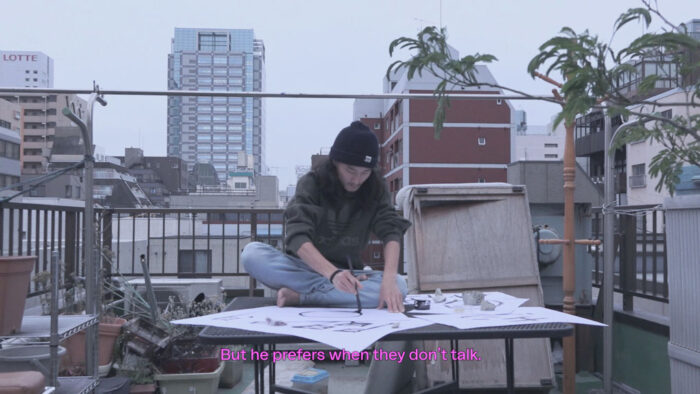Affects After Total Mediation
Ambient media and affective atmosphere: an interview with filmmaker Emilia Tapprest
NVISIBLE.STUDIO is the independent research practice of Finnish designer and filmmaker Emilia Tapprest. Her research explores visceral implications of rapid technocultural developments through speculative worldbuilding and cinema, working in close collaboration with historian and music producer Victor Evink (S x m b r a). Their works tackle themes such as human connectedness and agency in the age of datafication, exploring how a system’s underlying logic produces particular affective atmospheres in interaction with its social fabric. Her last film SONZAI.ZONE is a speculative fiction film on intimacy and loneliness after the normalization of ambient communication media. SONZAI.ZONE features in the programme of DEMO Moving Image Festival.
Felice Moramarco: Can you briefly outline the general concerns that animate your practice?
Emilia Tapprest: With my current practice as NVISBLE.STUDIO, I deploy worldbuilding and cinema to explore the implications that current technocultural shifts have on our lives. In particular, my research focuses on how designed systems condition our lifeworlds from an affective perspective. More generally, I’ve always been interested in investigating the inner logic of things and phenomena, which could be the behaviour of someone you love, as well as the functioning of a social system. And once you understand the immanent functioning of something, you can either just contemplate or try to change it. This approach is then connected to another interest that drives my practice, that is, investigating the ways in which we perceive reality both as individual and collective subjects, enforcing certain worldviews and creating specific affective atmospheres.

This idea of affective atmospheres seems to be central to your practice and I think that it also gives a sense of the mood that pervades your films, can you elaborate a bit more on this notion?
In my work I approach affective experiences as something that underlies emotional states and precedes conscious thinking, constituting that pre-individual level from which the subject emerges. So I find that in this context, the concept of atmosphere can be very useful, as it allows me to bound a subjective experience to the world that a specific subject inhabits. What I find also intriguing is the fact that, similarly to affects, an atmosphere is something that can’t be grasped nor exhaustively explained, but it can be shifted, interrupted and designed for. And this applies to all sorts of affective atmospheres, be it the one of going through security checks, the ambience in a club’s entry queue, or the more persistent undertone of occupying a particular position in society.
Is there a connection between the notion of affective atmosphere and the other theme central to your work, that is, datafication of people’s lives?
Definitely. By engaging with affective atmospheres, economical and political entities are able to orchestrate people’s affects for their own purposes, thanks to the use of technological apparatuses such as sensors, systems of pattern recognition and rapid feedback loops, which make people’s lives transparent and mouldable on a scale and precision that was previously unthinkable. This is something that with the current Covid-19 emergency is becoming even clearer: data-driven systems can become the most effective, and therefore dominant, apparatuses of governance. For example, many East Asian countries seem to have successfully minimised the economic damages caused by the outbreak, thanks to the use of digital contact tracing and other data-driven means. And beside the actual technologies that are deployed, what is crucial is the kind of political rhetoric that this approach to governance is generating, which will most probably affect future legislations.
So, in relation to these issues, for me, the central question is: which kind of world do we want to live in? Having a background in industrial design, I’m always accompanied by the awareness that most of our surrounding reality has been designed by someone, at some point in time, and according to specific purposes; not only objects and spaces, but also political protocols, platforms and interfaces, as for instance the ballot voting method in a local election or facial recognition payment methods that require smiling to complete the transaction. All these things implicitly manifest certain goals and beliefs. And most of them can be re-designed.

As you said, you started working on these topics already during your previous activity as a designer, why did you decide to shift to the moving image?
I studied collaborative and industrial design, and in this field you have to embrace what is currently possible as you’re working, as well as the dominant cultural and technological paradigms. There is, of course, some space for questioning and reinventing, but if you want to make something concrete to be implemented in scale—let’s say, a new strategy for public transport—you usually have to work with an incremental approach. In short, the field is oriented towards improving what already exists, rather than exploring potentially disruptive alternatives, which, instead, filmmaking allows you to do.
One of the first projects I realised as a designer, in the experimental field of embodied interaction, was a communication system called Lightbound which was intended to mediate the sense of someone’s presence from distance. I tested it with my mother for a few days and it was incredible to see the powerful effect it had on both of us. But in themselves, these kinds of living lab setups did not seem to offer tools to explore what might happen if such technologies became a new normal in society, as this sort of speculations require not only the expertise in specific fields, but also the ability to create concrete scenarios able to engage with real people and the world in which they live. At Sandberg Institute’s film department, I had the chance to reorient my research towards new directions. Here, I developed many of the ideas that now inform my practice, especially in dialogue with my tutor Daniel van der Velden (Metahaven), and I’ve also been able to discover the beauty of cinema, which I think consist of having the possibility of constructing immersive narrative universes: scenes can be entered, objects can be given a particular aura, intensities and moods can be orchestrated. And cinema also allows for the manifestation of affective atmospheres through a narrative and living experiences of people.
The characters of your films seem to be always in a confused psychological state: they talk only to themselves, their actions are often the result of an intense process of reflection and there is a sense of disorientation that is generally present. Do you think this is the effect that pervasive systems of mediation have on people?
Sonzai Zone speculates on a new kind of communication technology which is used for the control of human behaviours according to the logic of surveillance capitalism. And this condition is mirrored by the ways in which the characters of the film interact with the surrounding environment.
The communication systems present in Sonzai Zone do not function through screen-based devices, instead they operate remotely, connecting people through their feelings and bodily affects. This idea of ambient media technologies is based on researchers carried out in the field of Human-Computer Interaction since the 90s. The interfaces of such technologies are designed to transmit subtle and emotional signals, such as non-verbal body language, presence in space, or tactile expressions of care. Yet, in the film, these affordances create an immersive representation of the other that doesn’t correspond to reality, which ends up replacing the real person. And another aspect which adds to the sense of disorientation is that the characters of the film develop intimate relationships with their (personal) AI assistants, which blurs the boundaries between the machine and themselves.

You are now working on your upcoming project ZHŌUWÉI.NETWORK and it seems that while with Sonzai Zone you have defined one scenario of what a future data society could look like, with ZHŌUWÉI.NETWORK you are speculating on multiple possible realities that this landscape can generate, is this correct?
Yes, ZHŌUWÉI.NETWORK imagines three parallel near-future societies steered by different ideological paradigms, surveillance capitalism being only one of them. The other two consist of a harmony-driven technocracy set in 2037 Europe and a worldwide network of decentralised Commons- based micro-societies. Focusing on multiple scenarios allows me to tackle issues about datafication in a more nuanced way. The three worlds are portrayed as neither utopias nor dystopias, but rather as ideological poles useful to explore different possible ramifications and dilemmas emerging from data-societies. Each scenario unfolds through the everyday lives of the three protagonists of the film: V, S x m b r a, and Fei, whose personalities both mirror each other and reflect the society in which they live.
So ZHŌUWÉI.NETWORK is a very complex project. Are you collaborating with other people for its realisation?
ZHŌUWÉI.NETWORK is a project on which I have been working for one year and half together with historian of science and music producer Victor Evink. This project is also the first instantiation of our common practice LIMINAL.VISION. Our aim is to analyze the present technocultural and sociopolitical condition and speculate on possible future scenarios that might emerge from that. Victor’s background in the history of science, as well as in the field of underground music cultures is a fundamental contribution to this project as it gives him the ability to intercept diverse phenomena and draw connections among them. We are now developing the project in collaboration with scholars, researchers and artists from various backgrounds, including their present practice and expertise in the context of the project’s narrative universe.

Another element that connotes your films is the variety of languages spoken by the characters, is there a specific reason for that?
For a long time, I have been intrigued by the idea that different technological developments happen in parallel around the world, at different speeds and with different cultural by-products and I wanted to give a sense of this multiplicity of levels in my films as well. Also, portraying the future in different languages provides a glimpse of a world in which the cultural and linguistic dominance of English is not obvious.
In Sonzai Zone, references to geographical location, personal and broader historical contexts are deliberately left vague in order to enhance the atomised and disneyfied experience of the self and the other under global surveillance capitalism. On the other hand, ZHŌUWÉI.NETWORK, which is set in the same speculative future as Sonzai Zone, but 5 years later, extends the worldbuilding of the cinematic universe into a more elaborated scenario.





